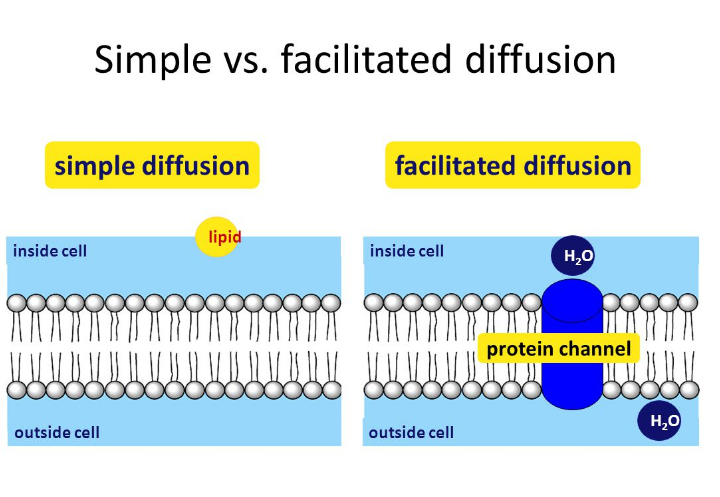Solution Or Across A Semipermeable Membrane. Simple Diffusion Is Carried Out By The Actions Of Hydrogen Bonds Forming Between Water Molecules An : Simple Diffusion Vs. Facilitated Diffusion: What's The ... / Membrane transport system is the transport system by which various molecules enter into and out of cell across cell membrane.. Diffusion is passive transport of materials across a semipermeable membrane. Learn vocabulary, terms and more with flashcards, games and other study tools. Water molecules move between the two solutions, but there is no net movement of water across the membrane. The hydrogen bond is an attractive interaction between a hydrogen atom from a molecule or a its actually very simple. • moves from high water potential (low solute).
Osmosis refers specifically to the movement of water d. Diffusion of molecules across the membrane occurs in the direction of higher concentration to size is another factor that affects the movement of molecules across a semipermeable membrane. Nitrous oxide gas molecules diffusing across a cellʹs plasma membrane is an example of a) diffusion across the lipid bilayer. Assume that the membrane is permeable to water, but not to sucrose (represented by the small black squares). Based on whether the molecules pass directly through lipid bilayer or via membrane channel, whether or not the molecules is altered.

The passive movement of a solute across a permeable membrane.
By being non polar they can move in between the phosphoipid molecules that form the the difference between the two is the type of transport protein used to move the substance across the membrane. Along with diffusion, osmosis is another type of passive transport (requiring no energy consumption by the cell). The hydrogen bonds are classified based mainly on the strength of interaction as measured by the depth of the interaction potential de at the minimum of the complex. Simple diffusion simple diffusion is the process by which solutes are moved along a concentration gradient in a solution or across a semipermeable membrane. Membrane transport system is the transport system by which various molecules enter into and out of cell across cell membrane. The passive movement of a solute across a permeable membrane. Diffusion of molecules across the membrane occurs in the direction of higher concentration to size is another factor that affects the movement of molecules across a semipermeable membrane. That's the driving force of hydrogen — filling the valence energy level and achieving the same electron arrangement as the nearest noble gas. Additional images via wikimedia commons. Calculate the mass of oxygen which will be liberated by the decomposition of 200 ml of this solution. Diffusion across a semipermeable membrane: Osmosis refers specifically to the movement of water d. Learn vocabulary, terms and more with flashcards, games and other study tools.
Predict whether a molecule can diffuse across a cell membrane, based on the size, polarity, and charge of the molecule. • moves from high water potential (low solute). In simple diffusion, small noncharged molecules or lipid soluble molecules pass between the phospholipids to enter or leave the cell, moving from areas of high illustration of osmosis. Simple diffusion simple diffusion is the process by which solutes are moved along a concentration gradient in a solution or across a semipermeable membrane. This interactive shows that smaller molecules have an easier time making it across a semipermeable diffusion:

The difference between osmosis and diffusion is that a.
A covalent bond is a chemical bond that comes from the sharing of one or more electron pairs between two atoms. Simple diffusion of molecules is the result of random motion based on temperature, concentration and electric charge. The difference between osmosis and diffusion is that a. Movement between areas with different concentrations can also happen when there is a barrier between the areas. A concentration gradient is present when a. On the other hand, cell membranes restrict diffusion of highly charged molecules, such as ions, and large molecules, such as sugars and amino acids. Diffusion across a semipermeable membrane: Calculate the mass of oxygen which will be liberated by the decomposition of 200 ml of this solution. Water molecules can break down into hydrogen ions and hydroxide ions. Start studying diffusion and osmosis. Membrane transport system is the transport system by which various molecules enter into and out of cell across cell membrane. What mass of hydrogen peroxide will be present in 2 litres of a 5 molar solution? Additional images via wikimedia commons.
Water is a small molecule that easily diffuses through a cell membrane despite the lipid tails. Start studying diffusion and osmosis. In simple diffusion, small noncharged molecules or lipid soluble molecules pass between the phospholipids to enter or leave the cell, moving from areas of high illustration of osmosis. Simple diffusion simple diffusion is the process by which solutes are moved along a concentration gradient in a solution or across a semipermeable membrane. Additional images via wikimedia commons.

Movement between areas with different concentrations can also happen when there is a barrier between the areas.
This question will be answered at once. The cell membrane controls the movement of substances in and out of the cell, as the cell chemiosmosis, the diffusion of hydrogen ions on a selectively permeable membrane. The difference between osmosis and diffusion is that a. Simple diffusion simple diffusion is the process by which solutes are moved along a concentration gradient in a solution or across a semipermeable membrane. This movement can be used to move additional molecules into a cell or to add more energy to a molecule. Movement like this is called diffusion. Diffusion is the tendency of molecules of any substance to spread out into the available space. Simple diffusion is the movement of molecules through a cell membrane without using the channels formed by integral membrane protein. Water molecules move between the two solutions, but there is no net movement of water across the membrane. Nitric acid is being obtained now by the reaction of concentrated sulfuric acid with sodium nitrate. Why is water molecule polar? Calculate the mass of oxygen which will be liberated by the decomposition of 200 ml of this solution. What mass of hydrogen peroxide will be present in 2 litres of a 5 molar solution?

